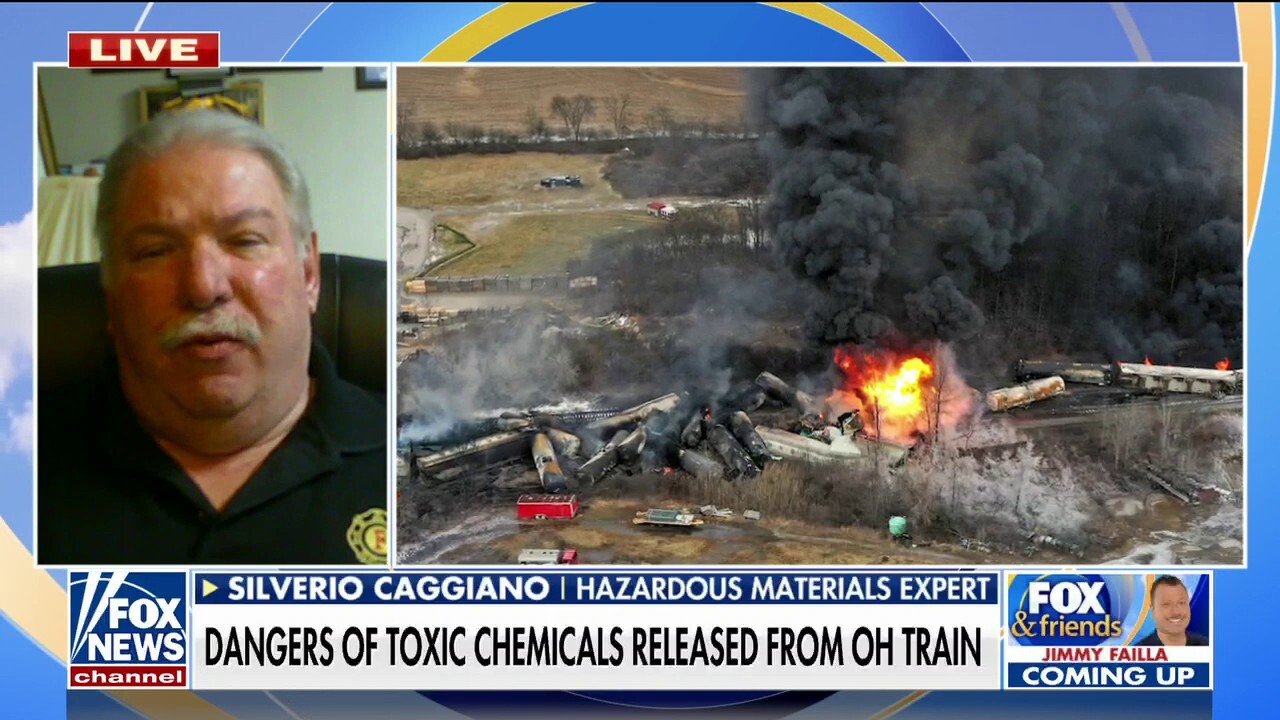Ohio Train Derailment: Toxic Chemical Lingering In Buildings For Months

Table of Contents
The Persistence of Vinyl Chloride and Other Toxins
Understanding Vinyl Chloride's Properties
Vinyl chloride, a highly volatile and carcinogenic chemical, is a major concern following the Ohio train derailment. Its volatility allows it to easily evaporate and spread, while its ability to permeate various materials is particularly troubling. Vinyl chloride can readily penetrate building materials like wood, drywall, and insulation, becoming trapped within the structure. Its relatively short half-life in the atmosphere doesn't negate the risk, as its persistence within building materials is a significant issue. This means that even after the initial release, vinyl chloride can continue to off-gas, exposing residents to harmful levels long after the initial incident.
- Off-gassing: Vinyl chloride slowly releases from contaminated materials over time.
- Solubility: It can dissolve in various building materials, making complete removal extremely difficult.
- Degradation Pathways: While it does degrade, the process is slow, and the byproducts can also be harmful.
Other Chemicals of Concern
Beyond vinyl chloride, the Ohio train derailment released a cocktail of other hazardous materials. The specific composition isn't fully known yet, but other persistent pollutants are likely present in affected buildings. These chemicals, along with vinyl chloride, create a complex mixture of toxic substances contributing to the long-term environmental contamination and increasing the long-term health risks.
- Butyl acrylate: A potential respiratory irritant.
- Ethylhexyl acrylate: Another potential irritant with possible long-term health effects.
- Other unidentified chemicals: The full extent of the chemical release and their long-term impact are yet to be fully determined.
The Ongoing Cleanup and Monitoring Efforts
Challenges in Remediation
Removing vinyl chloride and other toxins from porous building materials presents significant challenges. Current cleanup technologies, while effective in some situations, may not be fully adequate for addressing the pervasive nature of the contamination. Decontamination is a complex and expensive process, requiring specialized equipment and expertise.
- Cost of Remediation: The financial burden of a comprehensive cleanup is substantial.
- Time Required: Complete decontamination could take months or even years.
- Incomplete Removal: The possibility of residual contamination remains a significant concern.
Monitoring for Long-Term Effects
Ongoing monitoring of air and water quality is crucial to assess the long-term effects of the derailment. Regular testing of building materials for chemical residues is also necessary to gauge the extent of contamination and inform remediation strategies. Various agencies are involved in this monitoring process, providing data to inform public health decisions.
- Air Quality Testing: Regular sampling to detect the presence of volatile organic compounds (VOCs).
- Water Quality Analysis: Testing for chemical contamination in both surface and groundwater.
- Building Material Testing: Analyzing samples to determine the level of chemical penetration.
Long-Term Health Risks for Residents
Potential Health Impacts of Exposure
Exposure to vinyl chloride and other released chemicals carries significant long-term health risks. Vinyl chloride is known to be a potent carcinogen, increasing the risk of various cancers. Other health problems, such as respiratory illnesses, liver damage, and neurological issues, are also potential consequences. Comprehensive research is needed to fully assess the long-term impacts on the community.
- Cancer Risk: Vinyl chloride exposure is strongly linked to an increased risk of liver cancer, brain cancer, and lung cancer.
- Respiratory Illnesses: Exposure can lead to bronchitis, emphysema, and other respiratory problems.
- Liver Damage: Vinyl chloride is hepatotoxic, meaning it can damage the liver.
Addressing Community Concerns
Providing comprehensive medical support and information to affected residents is paramount. This includes access to healthcare services, mental health support, and educational resources on the health risks and available assistance programs. Open communication and transparency are crucial to build trust and address community concerns.
- Access to Healthcare: Ensuring residents have access to appropriate medical screenings and treatment.
- Mental Health Services: Providing support for stress, anxiety, and other mental health challenges.
- Community Education: Disseminating accurate information about the health risks and available resources.
Conclusion
The lingering presence of toxic chemicals, especially vinyl chloride, in buildings following the Ohio train derailment presents a significant and ongoing challenge. The long-term health risks for residents necessitate comprehensive and sustained monitoring, remediation efforts, and support for the affected community. Further investigation and transparency are crucial to ensure the safety and well-being of residents exposed to these persistent pollutants. Understanding the persistent threat of the Ohio train derailment's toxic chemical residue is paramount for effective mitigation and long-term community recovery. Stay informed about the latest developments and advocate for comprehensive cleanup and health monitoring initiatives related to the Ohio train derailment and its lasting consequences.

Featured Posts
-
 E Bay Faces Legal Reckoning Section 230 And The Sale Of Banned Chemicals
Apr 22, 2025
E Bay Faces Legal Reckoning Section 230 And The Sale Of Banned Chemicals
Apr 22, 2025 -
 Key Economic Themes From The English Language Leaders Debate A Summary
Apr 22, 2025
Key Economic Themes From The English Language Leaders Debate A Summary
Apr 22, 2025 -
 Tik Tok And Tariffs Examining The Just Contact Us Trend
Apr 22, 2025
Tik Tok And Tariffs Examining The Just Contact Us Trend
Apr 22, 2025 -
 Is Betting On Wildfires The New Normal The Los Angeles Case
Apr 22, 2025
Is Betting On Wildfires The New Normal The Los Angeles Case
Apr 22, 2025 -
 Bank Of Canada Interest Rate Pause Expert Analysis From Fp Video
Apr 22, 2025
Bank Of Canada Interest Rate Pause Expert Analysis From Fp Video
Apr 22, 2025
